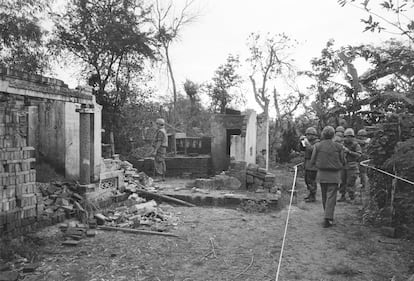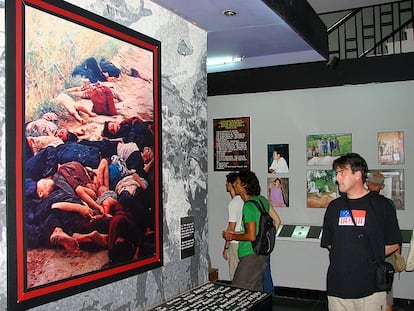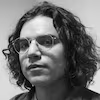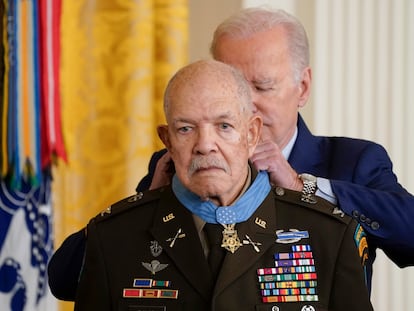Mỹ Lai Massacre: 55 years from the worst episode of the Vietnam War
US soldiers murdered hundreds of innocent women, children and elderly people. The Army tried to cover it up

The Mỹ Lai Massacre stands as one of the most infamous episodes in the history of the U.S. Army, and the most shocking event of the Vietnam War. More than 500 innocent, unarmed peasants were brutally murdered by a battalion whose orders — as some soldiers testified in subsequent trials — were to eradicate anyone in the area, including women (some of whom were gang raped), children and even animals. Members of different levels of the military subsequently tried to cover up the event, until a veteran of that same war took it upon himself to bring it to light, showing unexpected heroism within this dark story.
The Mission
In January 1968, the North Vietnamese Army and the Viet Cong launched a military operation called the Tet Offensive, one of their biggest escalations in the Vietnam War. The strategy focused on surprise attacks against military and civilian commandos and control centers throughout South Vietnam.
A month earlier, in December 1967, Charlie Company, 1st Battalion, 20th Infantry Regiment, 11th Brigade, 23rd Infantry Division, arrived in South Vietnam and spent several months without coming into direct contact with enemy forces. However, by mid-March, the company lost 28 members to traps or mines, including a popular sergeant in the ranks, which is considered one of the main reasons for the attacked that followed.
The Tet Offensive attacks were carried out in the Quảng Ngãi province by the Viet Cong’s 48th Local Forces Battalion. U.S. military intelligence assumed that the forces had subsequently withdrawn and dispersed to the village of Sơn Mỹ in that same province, which contained several villages designated Mỹ Lai. As part of the military strategy, a “search and destroy” operation was set up against the battalion.
For this mission, Task Force Barker, a battalion of the 11th Brigade led by Lieutenant Colonel Frank A. Barker, ground commander, was created to operate on the village of Sơn Mỹ. According to later testimony by those involved, Colonel Oran K. Henderson, commander of the 11th Brigade, instructed his officers to “go in aggressively, close with the enemy and wipe them out once and for all.” Similarly, Lt. Col. Barker ordered 1st Battalion commanders to burn houses, kill livestock, destroy food supplies, and poison wells.
According to official documents, the night before the massacre, Captain Ernest Medina of Charlie Company told his men that all civilian residents of Sơn Mỹ would be leaving the village for the market at 7 am, and that anyone remaining were possibly Viet Cong members or Viet Cong sympathizers. Some of the soldiers asked if that included women and children, and according to their later testimony, they understood that they were to kill both North Vietnamese and Viet Congs as well as “suspects,” even animals. One witness noted that the Captain said, “They’re all VC, now go and get them.” After being questioned about who was the enemy, he stated, “Anybody that was running from us, hiding from us, or appeared to be the enemy. If a man was running, shoot him, sometimes even if a woman with a rifle was running, shoot her.” One witness in particular noted that he remembered Medina instructing to destroy anything that “walked, crawled or growled.”
Varnado Simpson, a Company soldier said, “We were told not to leave anything standing. We did what we were told, regardless of whether they were civilians.”
The massacre
On March 16, 1968, at 7.30 am, Colonel Medina led about 100 Charlie Company soldiers, a small artillery and helicopter gunships into Sơn Mỹ, seeking to engage the Vietcong’s 48th Local Force Battalion. Near Mỹ Lai one of the helicopters fired on an armed group, killing four people.
Subsequently, the first two platoons entered Tu Cung village nearby, while the third platoon and Captain Medina’s command post were outside. As they approached, the two platoons shot at the people in the fields, even though they were not Viet Cong.
Women, children and the elderly were cooking breakfast on open fires, with some preparing to go to the market. Seeing the soldiers, they did not fight or panic as the troops led them into the common areas of the village.
Charlie Company gunner Harry Stanley testified that the killings began unexpectedly. He said that he saw a member of the first platoon hit a Vietnamese man with a bayonet, who also pushed another villager into a well, then threw a grenade into it. He also stated that he saw 15 to 20 people, mainly women and children, kneeling, praying around a temple. All were killed by gunshots to the head.
A group of 70 to 80 villagers were rounded up by the first platoon in Xom Lang. The soldiers pushed them into a ditch, where they were then shot to death. Private First Class Paul Meadlo said he shot old men and women (who were telling the soldiers “No VC” while protecting their children). He claimed he did so because he was convinced they all had grenade traps and would attack at any moment.

Another soldier, Dennis Konti, testified that William Calley, 2nd Lt. of 1st Platoon, Charlie Company, began shooting children who survived the first attacks. Others testified that they also killed livestock so that the Vietnamese could not re-settle in the villages.
These are just some of the horrific scenes of the massacre. Witnesses noted that soldiers set fire to huts, waiting for people to come out to shoot them or going in to kill them. “They were shooting women and children just like anybody else. We met no resistance and I only saw three captured weapons. We had no casualties. It was just like any other Vietnamese village – old papa-sans, women and kids. As a matter of fact, I don’t remember seeing one military-age male in the entire place, dead or alive”, noted Private First Class Michael Bernhardt.
The massacre continued with members of the 2nd Platoon killing about 70 Vietnamese north of Mỹ Lai. The 3rd killed a group of seven to 12 women and children. Charlie Company and Bravo Company arrived at Cổ Lũy where they killed between 60 to 155 people, including women and children. In addition to this, according to subsequent investigation, at least 20 Vietnamese women and girls were found to have been raped during the massacre, some by groups of soldiers.
At the end of the massacre, the Americans had only one casualty, which was a soldier who shot himself in the foot to avoid participating in the killings.
Heroes in the massacre
Hugh Thompson Jr., a technical officer, a helicopter pilot with B Company, 123rd Aviation Battalion, American Division, was one of the heroes who managed to save the lives of some of the innocent people in the area, and his testimony showed the brutality with which Charlie Company acted.
Before the massacre, the soldier was flying his Hiller OH-23 Raven observation helicopter along with gunner Lawrence Colburn and crew chief Glenn Andreotta after receiving orders to support Task Force Barker operations in Sơn Mỹ. The aircraft went out first to try to draw enemy fire, however, they were not attacked.
The Army bombed the area, killing several civilians, then gave way to Charlie Company towards Sơn Mỹ, led by Captain Ernest Medina, who gave orders to carry out the killing.
In the helicopter, Thompson was still doing reconnaissance in the area until he noticed the dead bodies of the villagers. “Everywhere we’d look, we’d see bodies. These were infants, two-, three-, four-, five-year-olds, women, very old men, no draft-age people whatsoever,” he told a conference about the events decades later.
First, the soldier and his crew thought the initial bombing had caused the deaths. On their tour they saw an injured civilian woman and Thompson requested medical evacuation using a green smoke signal (which meant it was safe to approach). However, they saw approaching Captain Medina who approached, kicked her, and shot her. “When we saw Medina do that, it clicked. It was our guys doing the killing.”
After that murder, Thompson discovered the ditch with Calley’s victims, so he decided to send a radio message toward Task Force Barker headquarters saying: “It looks to me like there’s an awful lot of unnecessary killing going on down there. Something ain’t right about this. There’s bodies everywhere. There’s a ditch full of bodies that we saw. There’s something wrong here.”
Noticing movement in the trench, Calley approached Thompson who questioned him about what happened, to which he responded that he was just following orders, before telling him to return to his helicopter. While this conversation was going on, Sergeant David Mitchell, Calley’s subordinate, fired into the ditch killing any civilians still alive.
Thompson decided to return to the helicopter with his crew, and they began searching for civilians they could save. They found a group of people fleeing from the 2nd Platoon, and realizing that the soldiers were ready to kill them. Thompson landed his helicopter between the two groups to protect the villagers and try to rescue them. Subsequent statements by Colburn and Andreotta indicated that Thompson ordered them to shoot the Platoon if they tried to kill any of the civilians. They took aim while the pilot tried to find as many people as possible, and to convince them to go with him to safety. The soldier enlisted the help of two UH-1 Huey pilots, who helped them evacuate the people.
Before leaving, Andreotta noticed movement in the body trench, where he was able to identify a living child, aged five to six years, covered in blood and in shock. The child was taken to a hospital in Quảng Ngãi.
Upon returning to headquarters, Thompson reported the situation to his superiors, including Lt. Col. Frank Barker, who ordered to stop the killings. Once his helicopter was refueled, he returned to the village to ensure that the wounded were evacuated and that there were no more murders.
Covering up the massacre
After Thompson made an official report of the massacre, he was interviewed by Colonel Oran Henderson. This caused other officers to call off similar operations against other villages in Quảng Ngãi Province, possibly preventing further massacres.
Initial reports on the event claimed that “128 Viet Congs and 22 civilians” had been killed in a village during an “intense firefight.” A report in Stars and Stripes magazine noted that U.S. soldiers killed 128 communists in a bloody day-long battle.
The first investigation into the Mỹ Lai operation was conducted by Colonel Henderson, who interviewed several soldiers involved in the incident, resulting in a report that stated that 20 civilians were inadvertently killed during the operation, which was accidental and attributed to long-range artillery fire.
For their part, Thompson and his comrades received decorations, however, the reasons for the awards told a different version of events, mentioning that Thompson took a Vietnamese child to a hospital after being caught in crossfire, and that his trial had improved U.S.-Vietnamese relations in the area. On his crew decorations, which also told other versions of events, Thompson’s signature was forged.
This showed attempts at various levels of the U.S. Army to cover up the events of the massacre, and to portray a more positive image of its involvement in the territory.
Ridenhour, Bringing the Truth to Light
Ronald L. Ridenhour, a door gunner with the Aviation Section, Headquarters Company, 11th Infantry Brigade, heard about the Mỹ Lai massacre during his time in Vietnam. While on active duty, he gathered testimonies and eyewitness accounts from soldiers who participated in the massacre.
Upon returning to the United States in March 1969, he sent a letter to thirty members of Congress, and to then-President Richard Nixon, asking them to investigate the “Pinkville” incident (as the area was nicknamed). Although most ignored his letter, Congressman Mo Udall pushed for the House Armed Services Committee to call Pentagon officials to conduct an investigation.
Under pressure from this letter, on September 9, 1969, the Army charged William Calley with premeditated murder of 109 South Vietnamese civilians near the village of Sơn Mỹ in the area known as Mỹ Lai.
Although the charges were filed quietly to avoid press attention, journalist Seymour Hersh, was able to obtain the indictments, allowing him to reveal the massacre to the American public, almost two years after the incident, on November 13, 1969, with an article in the Dispatch News Service.
Because the article threatened to minimize U.S. efforts in the Vietnam War (which was already dividing Americans in the late 1960s), within the White House, on the recommendation of National Security Advisor Henry Kissinger, the “Mỹ Lai Task Force” was established. Its mission was to maintain a united front within the government for opinions on the case, but it also focused on discrediting key witnesses, as well as questioning Hersh’s motives for publishing the story. This strategy was important in how the major figures in the case would be viewed by Americans, with some villains being painted as heroes, with the heroes being antagonized.

Heroes or villains
Colonel William Calley was put on trial on November 17, 1970. His first defense stated that the death of the villagers was caused by an accidental air raid. However, more than 100 witnesses denied this version. In his second defense he claimed that he was following orders from his superior, Captain Ernest Medina (who was cleared of all charges in a separate trial in August 1971).
A jury of six military officers (five of whom served time in Vietnam) convicted him on March 28, 1971 for the premeditated murder of 22 South Vietnamese civilians. On March 31, he was sentenced to life imprisonment with hard labor at Fort Leavenworth, in Kansas, the only one of the 26 soldiers and officers charged to receive punishment for his part in the massacre and in attempting to cover up the facts.
However, various U.S. political figures-including then-Georgia Governor and future President Jimmy Carter showed outrage over Calley’s sentence, with many noting that it was too harsh. Legislatures in Arkansas, Kansas, Texas, New Jersey and South Carolina called for clemency for the lieutenant colonel, while George Wallace, governor of Alabama visited him and asked Nixon — who up to that point had already shown favor for Calley — to give him a pardon.
In a poll of the American public, 79 percent disagreed with the verdict, while 81 percent believed his sentence had been too harsh, and 69 percent said he had been made a scapegoat.
Three days after his conviction, former president Nixon ordered him removed from prison and placed under house arrest at Fort Benning. He later had his sentence reduced to 20 years, which was later reduced to just 10.
He served only three years and four months of the sentence before getting his parole.
In 2009 he apologized for his involvement in Mỹ Lai: “There is not a day that goes by that I don’t feel remorse for what happened that day in Mỹ Lai. I feel remorse for the Vietnamese who were killed, their families, for the American soldiers involved and their families. I am very sorry.”
For his part, Hugh Thompson Jr., a hero who rescued people before they were killed, gave his testimony during his recounting at a closed hearing of the House Armed Services Committee, but was criticized by congresspeople, especially Mendel Rivers, who even pointed out that Thompson should have been the only soldier punished for the events at Mỹ Lai. Not for the massacre, but for pointing his guns at his fellow Americans. He even tried to have him court-martialed.
In 2004, the pilot confessed that he was antagonized by many Americans, both soldiers and commanders as well as citizens, for his testimonies against Army personnel: “I’d received death threats over the phone... Dead animals on your porch, mutilated animals on your porch some mornings when you get up.”
It wasn’t until 1989 that public perception changed. Thompson and his partner Lawrence Colburn were interviewed for the documentary Four Hours in Mỹ Lai (1989) where they gave an account of the events. The two would remain close friends for the rest of their days. Colburn was at the deathbed of Thompson, who passed away on January 6, 2006.
During a 1998 visit the two made to Mỹ Lai, Thompson noted that one of the women he had helped approached him and asked him the reason why the people who had committed these acts had not gone with him. The former pilot was devastated until she explained why she wanted to see them, “So we can forgive them.” He replied, “I’m not man enough to do that. I’m sorry. I wish I was, but I won’t lie to anyone. I’m not that much of a man.”
Tu suscripción se está usando en otro dispositivo
¿Quieres añadir otro usuario a tu suscripción?
Si continúas leyendo en este dispositivo, no se podrá leer en el otro.
FlechaTu suscripción se está usando en otro dispositivo y solo puedes acceder a EL PAÍS desde un dispositivo a la vez.
Si quieres compartir tu cuenta, cambia tu suscripción a la modalidad Premium, así podrás añadir otro usuario. Cada uno accederá con su propia cuenta de email, lo que os permitirá personalizar vuestra experiencia en EL PAÍS.
¿Tienes una suscripción de empresa? Accede aquí para contratar más cuentas.
En el caso de no saber quién está usando tu cuenta, te recomendamos cambiar tu contraseña aquí.
Si decides continuar compartiendo tu cuenta, este mensaje se mostrará en tu dispositivo y en el de la otra persona que está usando tu cuenta de forma indefinida, afectando a tu experiencia de lectura. Puedes consultar aquí los términos y condiciones de la suscripción digital.
More information
Archived In
Últimas noticias
Most viewed
- Sinaloa Cartel war is taking its toll on Los Chapitos
- Oona Chaplin: ‘I told James Cameron that I was living in a treehouse and starting a permaculture project with a friend’
- Reinhard Genzel, Nobel laureate in physics: ‘One-minute videos will never give you the truth’
- Why the price of coffee has skyrocketed: from Brazilian plantations to specialty coffee houses
- Silver prices are going crazy: This is what’s fueling the rally











































